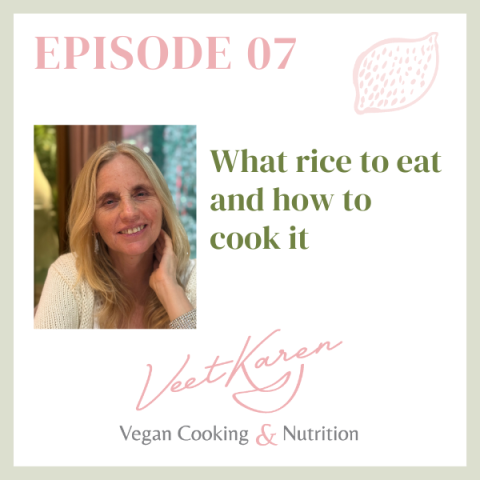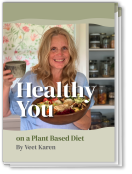
Episode 07
What is the best rice to eat
Rice is a fabulous source of nutrition and it is so versatile to cook with. In this episode, I talk about which rice to eat and how to eat and cook with it.
Listen Now
Show Notes and Links
https://www.veets.com.au/blog/wild-mushroom-and-black-rice-salad Mushroom and Black rice Salad
Introduction
Every time you decide to cook rice, do you wonder if it's the right thing to do?
Do you think you should or shouldn’t be eating rice?
Have you heard that carbohydrates aren't good for you?
I love rice.
I love carbohydrates.
There are lots of different types of rice and some are better than others.
In this episode of the Vegan Cooking and Nutrition Podcast, episode number seven, I'll be talking all about rice:
Which rice to eat
How to eat rice
What sort of dishes to make with rice
and of course, I've got the fun cooking tip at the end and a recipe.
What rice to eat
I talked about how I love eating carbohydrates. I do.
Carbohydrates are a brilliant fuel and they also have lots of nutrients in them.
You just have to be mindful of which carbohydrates you choose and that's going to be another podcast episode down the track.
What I'll just say in this episode is, we don't want to go for refined carbohydrates; we want them in their purest form and that's why rice is a great one to talk about.
White Rice
Well, I have to admit my go-to treat is white rice.
I love white rice; it's just a very comforting food.
I think my nervous system just relaxes when I eat it and I feel like I'm having a definite treat.
But it is refined, so it's not the rice to go to for every day, that's for sure. With white rice, the husk layer and the bran layer are removed and a lot of nutrients are lost in that process.
So it isn't the rice to rely on to get your B vitamins and other nutrients that you can get from rice, which I'll be going through in this show.
White rice is, however, a low GI food, and some studies show that it can assist in helping you sleep at night, except for Arborio because Arborio is quite full of starch, so that's probably the worst white rice to eat.
But isn't it yummy when you make a delicious risotto?
Brown Rice
Brown rice has a high fibre content, which is super good for anything like diabetes and also for bowel health.
Brown rice is anti-inflammatory and its high fibre content has been shown to reduce weight. An older study found that in 40 overweight women, there was a significant difference in body weight reduction for those who ate brown rice instead of white rice.
There was also a drop in blood pressure.
I love to make brown rice and then save it because when it's eaten cold, it becomes a resistant starch, which is also good for bowel health. I'll be doing a full podcast on resistant starch because that's very fascinating.
The next day, I'll have it and put it through my salads or make fried rice with the brown rice. Sometimes brown rice is nice dropped into soups, especially if they're Asian-style soups.
Red Rice
Then there's red rice, which is less popular, but my sister-in-law, who is from Timor-Leste, first put me on to red rice 20 years ago because they grow red rice in Timor-Leste. They also substitute white rice because white rice is cheaper, but they'll do half white rice, half red rice. Red rice does take longer to cook than white rice. White rice can take just 10 minutes to cook, whereas red rice can take 20 minutes to cook.
For one cup of cooked red rice, I actually thought there was a lot more protein in red rice than brown rice, but there isn't.
There's four to five grams of protein in one cup of cooked red rice. Red rice contains iron, calcium and potassium and is rich in fibre. It contains zinc as well. It's been known to lower blood glucose levels, so it's a great choice for people with diabetes. It has that wonderful antioxidant in it, which I struggle to pronounce but I'll do my best: anthocyanin. Anthocyanins are found in foods that are red, blue, purple, and yellow-orange in colour. They can be a remedy for liver dysfunction, prevention of cancer and vision disorders. Even if you're young listening to this, we need to be looking after our eye health in particular so that we don't get cataracts in our later years.
Some studies have shown that anthocyanins can help with skin diseases like eczema and dermatitis. It's really good to vary the rice you eat, not always eating brown rice, for example. You can make a combination of brown and red rice or have red rice on its own sometimes.
Black Rice
One of the very best rice is black rice, and that is my favourite rice because of the colour. It's black-bluish in colour and also contains anthocyanins. It also contains potassium, calcium, vitamin E, lutein and zeaxanthin, which are really good for eye health. In one cup of cooked black rice, you have a whopping eight grams of protein, so it's a really good source of protein.
Wild Rice
Then there is wild rice. Wild rice is not in the same family as the other rice; it belongs to the Zizania plant group.
Wild rice is the long grain portion of the grass, so it's chewier. It is also super expensive. For example, brown rice can cost $9.95 a kilo while wild rice costs $33.95 a kilo.
Some people don't like wild rice when it's fully on its own, so it is good to sometimes mix it because it is chewier. It has no sodium in it, so it's super good for blood pressure and preventing heart issues like atherosclerosis. It has six to eight grams of protein per cup of cooked wild rice, so it is a good one to have, but it's not sustainable to have it all the time.
What rice to cook with what
With red rice, I use it to have it with curries, especially if they're Southeast Asian curries. I just love red rice with curries. If I'm making a burger, I'll pop the red rice in.
When I make rice balls, I cook them with a mixture of black and brown rice or red and brown rice. The cooking times for black, brown and red rice are similar.
How to cook rice
With white rice, you don't need to soak it. Many people rinse all the starch off and then they find that it's a little healthier. You can just put the white rice, say if you've got a cup of basmati rice; you can use the absorption method, where you put a cup of basmati rice and two cups of water, add your salt and a pinch of turmeric if you're making it festive. Bring it to the boil, turn it down to the lowest you can, maybe just put the lid a little bit off so that some of the steam can come out. Put the timer on for 10 minutes, turn it off, let it sit for five minutes and you'll have the perfect fluffy rice.
How to get more volume of rice when cooking it
However, if you're cooking a lot and you want more volume, then you cook it in lots and lots of water because the rice absorbs more water, and you get more volume of rice, so it's more economical. I learned that with catering. Normally, we say it's about a third of a cup of basmati rice per person, but when you do it with lots and lots of water, they only need a quarter cup of rice because the rice almost doubles.
Try cooking the basmati rice with the absorption method which involves adding one cup of rice to two cups of water, and then what I call the immersion method. In this method, you have lots of water, put the rice in when the water is boiling, cook it for 10 minutes, and then strain all the excess water off. You'll see the yield is much higher.
Soaking whole grain rice (this episode’s fun cooking tip)
For unrefined whole grain rices like brown rice, black rice, wild rice, and red rice, it's super good to soak them overnight.
If it's really hot weather, put them in the fridge in the soaking water.
When you go to cook it, rinse off the soaking water and then cook.
You can use the absorption method or the immersion method.
The absorption method is just double the amount of water to rice.
However, when you've soaked the rice it has taken up some of the water, so for example, for one cup of brown rice, you usually need two cups of water, but you need less because it's already been soaked. If it's one cup of brown rice, I will use one and a half cups of water.
The beauty of soaking it is to get rid of the oxalates and the phytic acid, which is another episode in the making. The real big beauty is also that it takes less time to cook. If you haven't soaked brown, red or black rice, it can take 50 minutes to cook, but when you've soaked it overnight, it will take 20 minutes, maybe 30, but usually it's done in 20 minutes, so that's a really big win.
Click here for this week’s recipe
It's black rice and lentil salad with mushrooms, yum! If you don't like mushrooms you can choose some other vegetable but the mushrooms are just adding even more B vitamins.
You soak a quarter of a cup of black rice and a quarter of a cup of lentils of your choice overnight, then cook them. In the recipe it tells you how to cook them. Then you fry up 250 grams of mixed mushrooms. When I go to the market I can get a tray of mixed mushrooms for $9. It has oyster mushrooms, normal mushrooms, chestnut mushrooms, king mushrooms, lion's mane and wood ear mushrooms.
Fry them up, steam a green of your choice like asparagus when it's in season, or fresh beans or broccoli. Dry fry some pine nuts so they're nice and brown. You can add rocket or some other herb and then just put on some balsamic vinegar. It is delicious. So good.
I hope that's helped you with choosing what rice to have and how much to have. I soak a quarter cup per person, but then you've got to make sure you've got other things with protein in it so that you get your full 16 to 20 grams of protein per meal, depending on how much protein you need a day. I only need 16 grams of protein per meal.
Please subscribe, like and let your friends know about this podcast because I really want to get this information out to people.
Have a sensational week cooking, and I can't wait to talk with you next week. Bye!




